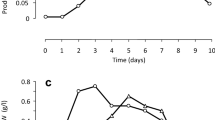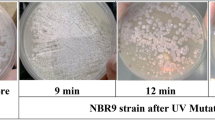Abstract
Streptomyces sp GE44282 was isolated in the course of a screening program for novel antibiotics. It co-produces heneicomycin and aurodox, two kirromycin-type antibiotics, which differ by the presence of an hydroxyl group at the C30 position of aurodox. Heneicomycin is converted into aurodox both by growing and resting cells ofStreptomyces sp GE44282 and by the producer of aurodox,Streptomyces goldiniensis ATCC 21386. This bioconversion of heneicomycin is substrate-specific and is not observed using the producer of heneicomycin,Streptomyces filippiniensis NRRL 11044. The three strains show very similar taxonomic characteristics. These results suggest that heneicomycin is a precursor of aurodox, the production of which depends on the bioconversion capability expressed by the strain.
Similar content being viewed by others
References
Atlas RM. 1993. Handbook of Microbiological Media (Parks LC, ed), CRC Press, Boca Raton, Florida, USA.
Barber J, AE Derome, TD Howard, L Lian and G Tebb. 1989. Full assignment of the1H and13C NMR spectra of the antibiotic kirromycin (mocimycin). Magnetic Resonance in Chemistry 27: 748–753.
Beretta G, F Le Monnier, E Selva and F Marinelli. 1993. A novel producer of the antibiotic kirromycin belonging to the genusActinoplanes. J Antibiotics (Tokyo) 46: 1175–1177.
Berger J, HH Lehr, S Teitel, H Maehr and E Grunberg. 1973. A new antibiotic X-5108 ofStreptomyces origin. I. Production, isolation and properties. J Antibiotics 26: 15–23.
Edwards DMF, E Selva, S Stella, LF Zerilli and GG Gallo. 1992. Mass spectrometric techniques for structure and novelty determination of kirromycin-like antibiotics. Biol Mass Spectrometry 21: 51–59.
Ferrari P, DMF Edwards, GG Gallo and E Selva. 1990. Antibiotic SB22484: a novel complex of the kirromycin-like group: II. Structure elucidation of the four factors. J Antibiotics 43: 1359–1366.
Frost BM, ME Valiant, B Weissberger and EL Dulaney. 1976. Antibacterial activity of efrotomycin. J Antibiotics 29: 1083–1091.
Frost BM, ME Valiant and EL Dulaney. 1979. Antibacterial activity of heneicomycin. J Antibiotics 32: 626–629.
Gullo WP, SB Zimmerman, RS Dewey, O Hensens, PJ Cassidy, R Oiwa and S Omura. 1982. Factumycin, a new antibiotic (A40A): fermentation, isolation and antibacterial spectrum. J Antibiotics 35: 1705–1707.
Hall CC, JD Watkins and NH Georgopapadakou. 1989. Effects of elfamaycins on Elongation Factor Tu fromEscherichia coli andStaphylococcus aureus. Antimicrob Agents Chemother 33: 322–325.
Kempf AJ, KE Wilson, OD Hensens, RL Monaghan, SB Zimmerman and EL Dulaney. 1987. L-681, 217, a new novel member of the efrotomycin family of antibiotics. J Antibiotics 39: 1361–1367.
Langham CD, ST Williams, PHA Sneath and AM Mortimer. 1989. New probability matrices for identification ofStreptomyces. J Gen Microbiol 135: 121–133.
Liu CM, H Maher, M Leach, M Liu and PA Miller. 1977. Biosynthesis of aurodox (antibiotic X-5108). Incorporation of14C-labelled precursors into aurodox. J Antibiotics 30: 416–419.
Liu CM, TH Williams and RG Pitcher. 1979.13C-NMR studies on the biosynthesis of aurodox (antibiotic X-5108). J. Antibiotics 32: 414–417.
Parmeggiani A and GM Swart. 1985. Mechanism of action of kirromycin-like antibiotics. Ann Rev Microbiol 39: 557–577.
Parmeggiani A and G Sander. 1980. Properties and action of kirromycin (mocimycin) and related antibiotics. In: Topics in Antibiotic Chemistry (Sammes PG, ed), pp. 159–221, Ellis Horwood, Chichester, UK.
Selva E, G Beretta, R Pallanza, BP Goldstein, M Berti, DMF Edwards and M Denaro. 1990. Antibiotic SB22484: a novel complex of the aurodox group. I. Taxonomy of the producing organism, isolation of the antibiotics and chemical and biological characterization. J Antibiotics 43:1349–1358.
Sneath PHA. 1979. BASIC program for identification of an unknown with presence-absence data against an identification matrix of percent positive characters. Computers & Geosciences 5:349–357.
Staneck JL and GD Roberts. 1974. Simplified approach to identification of aerobic actinomycetes by thin-layer chromatography. Appl Microbiol 28:226–231.
Williams ST, M Goodfellow, G Alderson, EMH Wellington, PHA Sneath and MJ Sackin. 1983. Numerical classification ofStreptomyces and related genera. J Gen Microbiol 129: 1743–1813.
Wolf H and H Zähner. 1972. Stoffwechselprodukte von mikroorganismen. 99. Mitteilung. Kirromycin Arch Mikrobiol 83: 147–154.
Zimmerman SB, JH Chalmers Jr, RS Dewey, EO Stapley and S Hernandez. 1979. Heneicomycin, a new antibiotic (A21A): fermentation, isolation and antibacterial spectrum. J Antibiotics 32:665–666.
Author information
Authors and Affiliations
Rights and permissions
About this article
Cite this article
Marinelli, F., Stella, S., Montanini, N. et al. Bioconversion capacity ofStreptomyces sp GE44282, a producer of the antibiotics heneicomycin and aurodox. Journal of Industrial Microbiology 15, 49–54 (1995). https://doi.org/10.1007/BF01570013
Received:
Accepted:
Issue Date:
DOI: https://doi.org/10.1007/BF01570013




